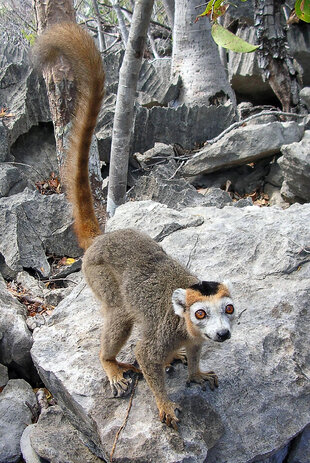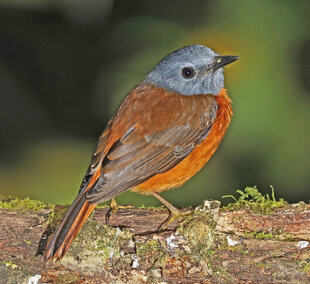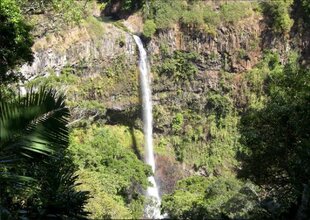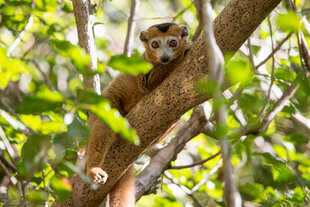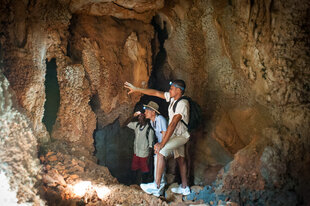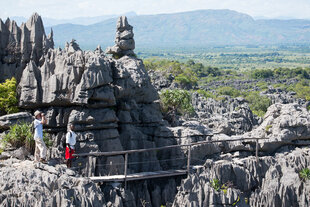This journey to the far north of Madagascar offers an incredible range of what the country has to offer, including rocky mountains cloaked in rainforest; Indian Ocean islands; caves, caverns and tropical wildlife havens within forests of limestone needles, called tsingy.
One of our main ports of call will be the Amber Mountain National Park (Montagne d'Ambre). This was Madagascar's first national park for good reason: not only it is an island of tropical rainforest within a semi-arid region, but its landscapes are an Eden of waterfalls, volcanic lakes and rocky cliffs covered in luxuriant vegetation.
This journey will take you on a tour of three magnificent waterfalls within Amber Mountain, at the same time searching for some of Madagascar's classic endemic species. Madagascar is home to about half of the 150 species of chameleons which exist in the world and Montagne d'Ambre has two of its very own endemics: the larger and very attractive Amber Mountain Chameleon (Calumma amber); and one of the tiny Brookesia species, Montagne d'Ambre Leaf Chameleon.
The altitudinal range of Amber Mountain (between 850m and 1475 m) encourages a high diversity of flora, amongst which we can find up to 77 species of bird. Of lemurs, we can find 7 species, including Sanford's Brown Lemur (Eulemur sanfordi) and the Crowned Lemur (Eulemur coronatus).
A book by primatologist Jane Wilson called Lemurs of the Lost World, made the Crowned Lemur best known for our next target of this trip: the Ankarana Reserve. There are two major areas of tsingy in Madagascar and Ankarana is the one most hollowed out from below by underground rivers. In fact, Ankarana has the most extensive system of caves anywhere in Madagascar or continental Africa. Expeditions continue to explore the area, with one of the most recently discovered species being a blind form of Gobi fish. This Ankarana Cavefish makes up for a total lack of vision with a highly sensitive sense of feel achieved through collections of sensory hairs on its scales.
The sharp rocks of Ankarana make it incredibly difficult to move about it, which is why Nature has survived so untouched here for centuries. To help you see it close up and absorb some stunning views, we use a system of suspended rope bridges, which take you above the razor-sharp limestone karst. Below, you will sometimes be able to see how Crowned Lemurs deftly leap from one knife edge to the next.
96 species of bird exist at Ankarana and 14 species of bat, some of which you will be able to see when we take you amongst the stalagmites and stalactites of caves within the limestone massif.
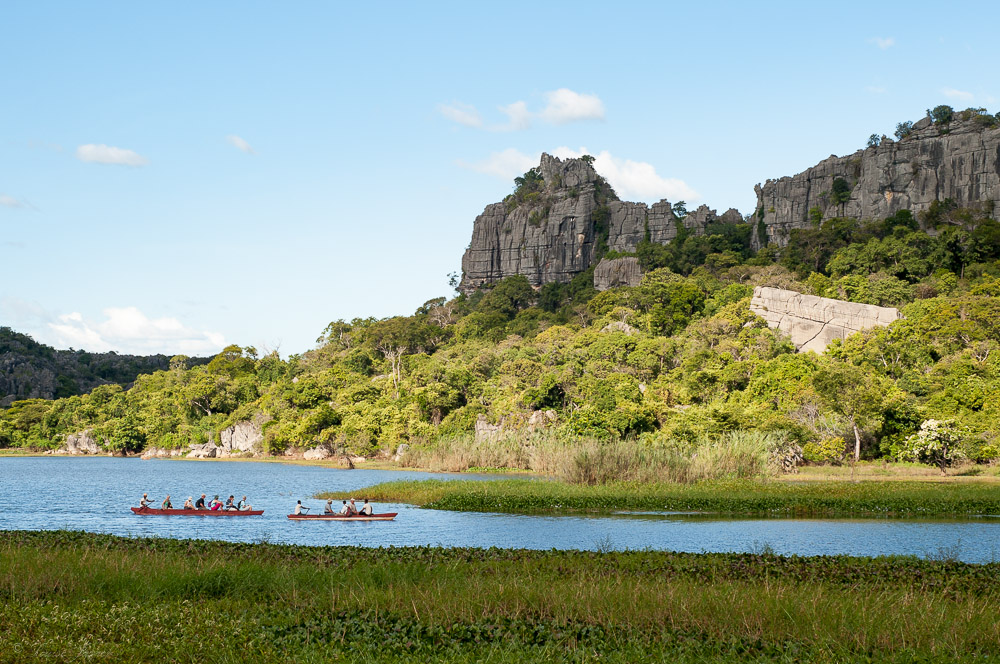
Approaching the Tsingy Massif at Ankarana from bush camp Iharana
Another location we will take you to on this trip is the Red Tsingy, as well the beautiful island of Nosy Be where you will spend your first night of the trip, overlooking turquoise waters of the Indian Ocean.
Itinerary
Tsingy, Amber Mountain, Cap d'Ambre (6 days privately guided)
null
Day 1 – Arrive Nosy Be
You can arrive into Nosy Be at any time today, where you will be met and transferred to a lovely beachside hotel.
Day 2 - Nosy Be to Red Tsingy & Joffreville
Early morning we will be collected from your hotel and drive to the harbour of the capital of Nosy Be, Hellville. From here we will take you by speed boat to the mainland at Ankify. This will take about 40 mins.
At Ankify, we will meet our vehicle and local guide and drive to the town of Joffreville, which lies just outside of the Montagne d'Ambre National Park. This drive takes about 4.5 - 5 hours total, on a combination of tarred road and laterite track.
En route you will stop at the Red Tsingy, which is actually an artistic example of extremely eroded laterite (click HERE for details). From here, we will proceed to a lodge with views of of Indian Ocean and rainforest.
This evening your guide will take you on a night walk in the 300 hectare private Fontenay reserve where more than 8,000 trees have been planted so far.
Day 3 - Amber Mountain (Montagne d'Ambre) & Ankarana East
Daytime today will be devoted to exploring the National Park of la Montagne d'Ambre. Our rainforest walks will take you to some of most beautiful waterfalls and volcanic lakes in Madagascar; and provide opportunities to see some of the area's 77 species of birds, 7 species of lemur and 24 species of amphibian.
From the Amber Mountain National Park, you will be driven to the eastern edge of the Ankarana Tsingy Massif.
Day 4 - Ankarana East to West
Breakfast at the lodge before setting out for a half day to discover the eastern section of the Ankarana Reserve. The walk can take from two to six hours, depending on path you choose. Options include a suspension bridge, canyon, baobabs and caves.
In the afternoon, you will be driven to the western edge of the Ankarana Massif.
Day 5 - Ankarana South West
This morning you will explore the tsingy by means of walkways above it. This provides some fantastic panoramas and allows you to peer into the world of the Crowned Lemur and birds and reptiles that live in green oases amongst the sharp rocks. You will walks for about 3 ½ hours, taking in a place known as Chameleon Cave.
In the afternoon you will be taken to explore the Mandresy Cave, famous for its Madagascan Flying Foxes and some stunning stalactites and stalagmites. Following that you will explore by pirogue.
Day 6 - Western side of Ankarana - Ankify - Nosy Be
After breakfast, you will head by road to Ankify on the Indian Ocean. En route you will cross the Valley of Sambirano known for its cocoa plantations.
You will eventually board a speedboat which will take you back to Nosy Be.
Private transfer to Nosy Be airport, or wherever else you need to be for your onwards travels.
Dates
per person sharing based on group of 4
Add £590 for 2 person private safari
Single room occupancy add £250
per person sharing based on group of 4
Add £650 for 2 person private safari
Singe room occupancy add £275
Prices include
All accommodation
All transportation starting & ending Nosy Be
Private 4WD & driver guide between locations
Breakfasts
Dinners on mainland Madagascar
All guiding
National park entry fees
Taxes
Not included
Flights
Travel insurance
Drinks
Lunches
Dinners on Nosy Be
Tips
Items not specified in the itinerary

